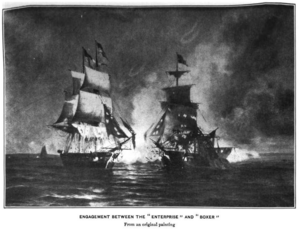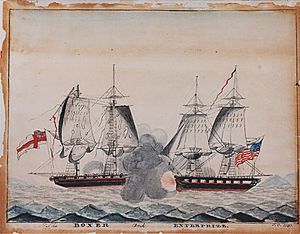Capture of HMS Boxer facts for kids
Quick facts for kids Capture of HMS Boxer |
|||||||
|---|---|---|---|---|---|---|---|
| Part of the War of 1812 | |||||||
 |
|||||||
|
|||||||
| Belligerents | |||||||
| Commanders and leaders | |||||||
| Strength | |||||||
| 1 gun-brig Sailors and Marine infantry |
1 brig Sailors and Marine infantry |
||||||
| Casualties and losses | |||||||
| 1 gun-brig captured | 1 brig damaged | ||||||
The capture of HMS Boxer was an important sea battle during the War of 1812. It happened off the coast of Maine in 1813. The American ship, USS Enterprise, was a brig commanded by Lieutenant William Burrows. The British ship, HMS Boxer, was a gun-brig led by Commander Samuel Blyth. The Enterprise was originally built in 1799 and later rebuilt as a brig. After the battle, the Boxer was sold and used as a merchant ship.
The Battle of HMS Boxer
On September 5, 1813, the USS Enterprise spotted HMS Boxer near Pemaquid Point, Maine. The Enterprise had fourteen 18-pound cannons and two 9-pound long guns, with 102 crew members. The Boxer had twelve 18-pound cannons and two 6-pound long guns, with 66 crew members.
After six hours of careful maneuvering, the two ships finally began to fight. Both commanders were ready for a fierce battle. Commander Blyth of the Boxer had a British flag (Union Jack) nailed to his ship's masts. This showed he would not surrender. Lieutenant Burrows of the Enterprise was just as determined. He moved one of his cannons to the back of his ship. He said they would fight with "both ends and both sides" of the ship.
The ships opened fire when they were very close. Commander Blyth was killed almost immediately by a cannonball. Moments later, Lieutenant Burrows was also badly wounded by a musket ball. He refused to go below deck, wanting to stay with his crew.
The intense fight lasted only 30 minutes. Lieutenant Edward McCall took command of the Enterprise. Lieutenant David McGrery took command of the damaged Boxer. The Boxer was severely damaged, with water filling its lower deck. Even though some of its flags were shot away, the main flag remained nailed to the mast. However, the British ship had to surrender.
Lieutenant Burrows, dying, refused to accept Commander Blyth's sword. He asked for it to be sent to Blyth's family. Burrows said, "I am satisfied, I die contented." Lieutenant McCall then took both ships and the wounded back to Portland.
After the Battle
Newspapers in the United States celebrated this "brilliant naval victory." After the battle, a large state funeral was held for both commanders. Lieutenant Burrows and Commander Blyth were buried side by side in Portland's Eastern Cemetery. This was a powerful sight, as two commanders who had fought fiercely against each other were laid to rest peacefully together.
The famous American poet Henry Wadsworth Longfellow later wrote about this battle in his poem "My Lost Youth":
"I remember the sea-fight far away,
How it thundered o'er the tide!
And the dead captains, as they lay
In their graves, o'erlooking the tranquil bay
Where they in battle died."


